Stardew Valley What to Grow in the Greenhouse
When Stardew Valley players kickoff inherit their family farm, they might be puzzled to see a broken-down old edifice in the northwest area. Upon completing the Pantry bundles in the Community Eye, however, this building's purpose becomes clear: It's a greenhouse, with a 12x12 plot of tillable soil.
Subsequently the Junimos restore this edifice, players tin can use this area to grow whatsoever ingather in whatever flavour. When new players kickoff gain this astonishing resources, though, some aren't sure how to utilise it most finer. Hither's a list of crops that aid turn the greenhouse into a money-making machine.
Updated December half-dozen, 2021 by Demaris Oxman: With Stardew Valley recently coming to Xbox Game Laissez passer, enough of new players will exist stepping into Pelican Boondocks for the first time. Building a farm from the ground upwards is no easy job, merely with the greenhouse, players become a little extra space to grow their virtually profitable crops in whatever season they delight. As both longtime fans and newcomers alike continue to notice solace in this peaceful farming sim, here are a few more crops perfect for growing in the greenhouse, and more detailed information on how to go the nigh out of these items.
14 Mixed Seeds
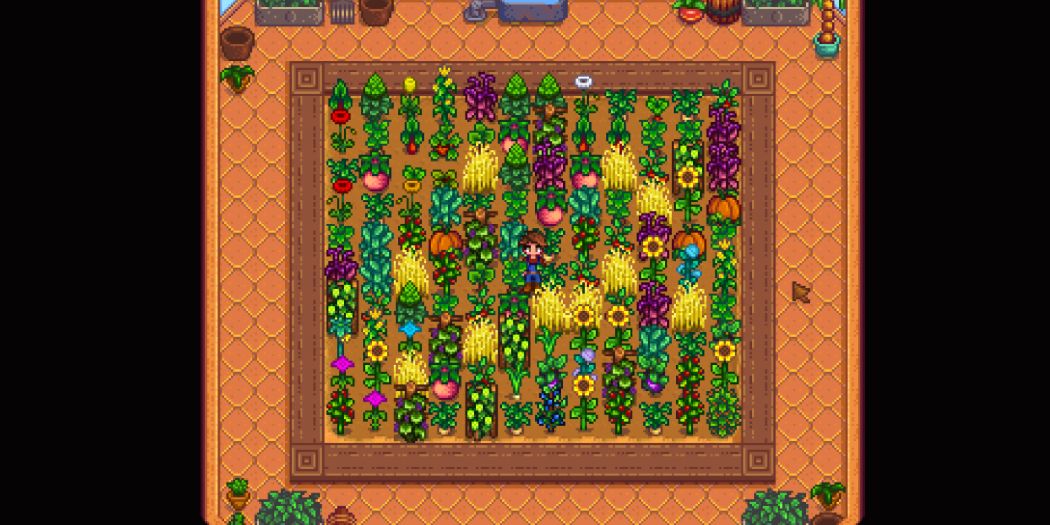
These are a cool pick for greenhouse farming, simply considering it makes them more interesting. When planted outside, mixed seeds will grow into one of that season's crops. Even so, in the greenhouse, they may grow into a crop from any season.
Corn, peppers, wheat, eggplant — any of these and more than could grow from mixed seeds. Information technology'south fun to attempt out in wintertime, especially early in the game. Plant them and run into what grows; maybe utilise their products in the Seed Maker to save some money next flavour.
Costs & Profits
- Seed Costs: 0g. Players can discover Mixed Seeds by cut weeds, digging, mining, and more.
- Profits: Highly variable, depending on what grows from the seeds.
13 Qi Fruit
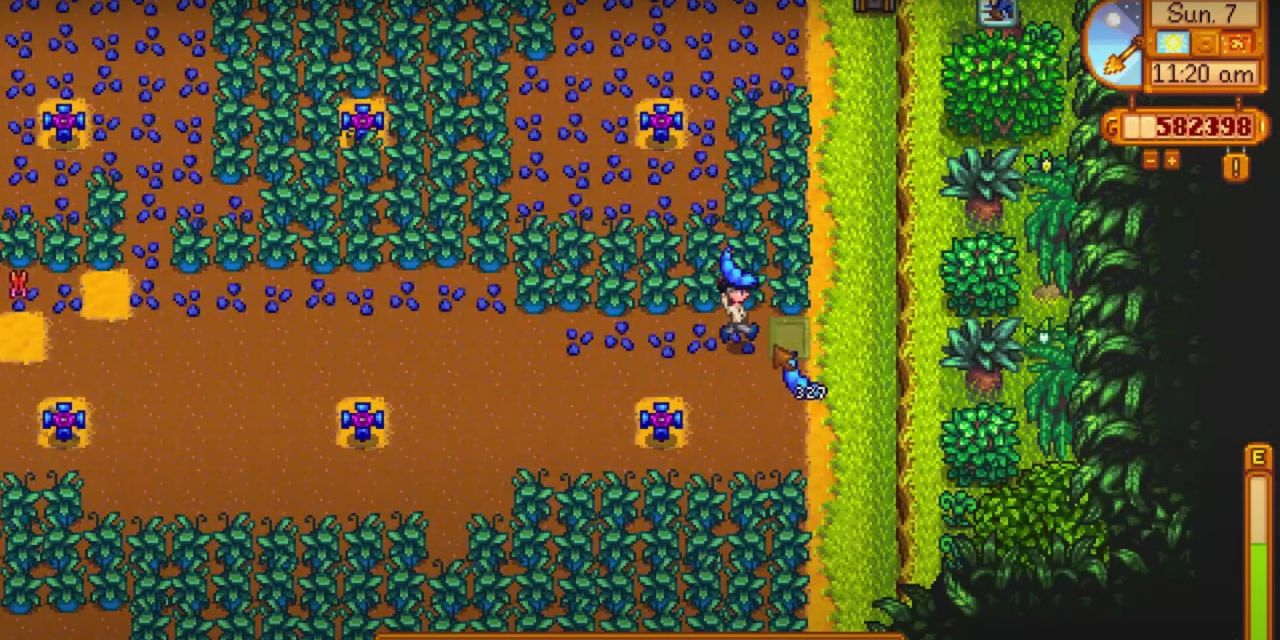
One of Mr. Qi's many challenges to the player, bachelor from his secret room on Ginger Island, is "Qi's Ingather," which requires the player to cultivate and transport 500 Qi Fruit by the end of the calendar month. Players will find the necessary seeds, or "Qi Beans," by chopping down trees, digging in artifact spots, and more.
With such a vast amount of produce to grow, many players find they need all the infinite they tin can go — especially since many have already dedicated their farming space to seasonal crops. The greenhouse can thus come in extremely handy, providing some extra growing infinite.
Toll & Profits
Qi Beans cannot be purchased; players must find them as described above or apply the Seed Maker. The fruit itself ships for only 1g each; yet, completing the challenge volition reward the player with 100 Qi Gems.
12 Tea Bush
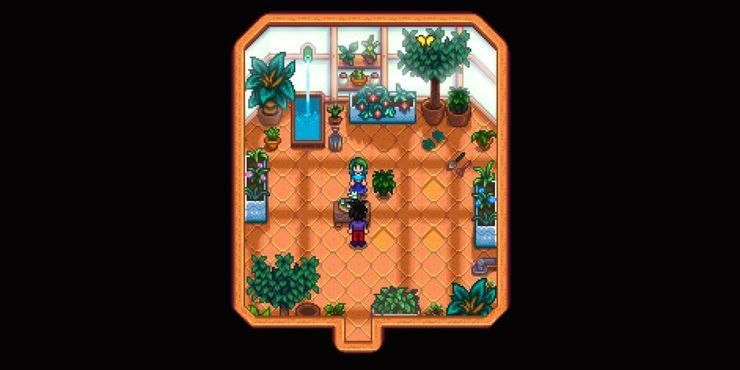
These little green trees volition produce Tea Leaves every day during the last calendar week of Spring, Summer, and Fall — and, if planted in an indoor location such as the greenhouse, Wintertime. Players can constitute them in untilled soil as with a Fruit Tree, or in a garden pot.
The Tea Bush-league takes 20 days to mature, and thus will produce leaves for the whole last week if planted at the outset of a flavour. Tea Leaves can be placed in a keg to make Green Tea, which gives the player a massive boost to their max free energy: +30 for 4 minutes and 12 seconds. They can also be pickled like other vegetables.
Cost & Profits
After witnessing Caroline'due south 2-middle outcome in her sunroom, she will send the role player a crafting recipe for a Tea Sapling, which can exist planted to abound into a Tea Bush-league:
- ii Wild Seeds (any)
- v Fiber
- 5 Forest
When selling, the Tea Leaves do good from the Tiller profession, which increases profits past ten%. Light-green Tea and Pickles both benefit from the Artisan profession, increasing their value by 40%.
| Item | Without Tiller/Artisan | With Tiller/Artisan |
|---|---|---|
| Tea Leaves | 50g | 55g |
| Greenish Tea | 100g | 140g |
| Pickled Tea Leaves | 150g | 210g |
11 Pineapple
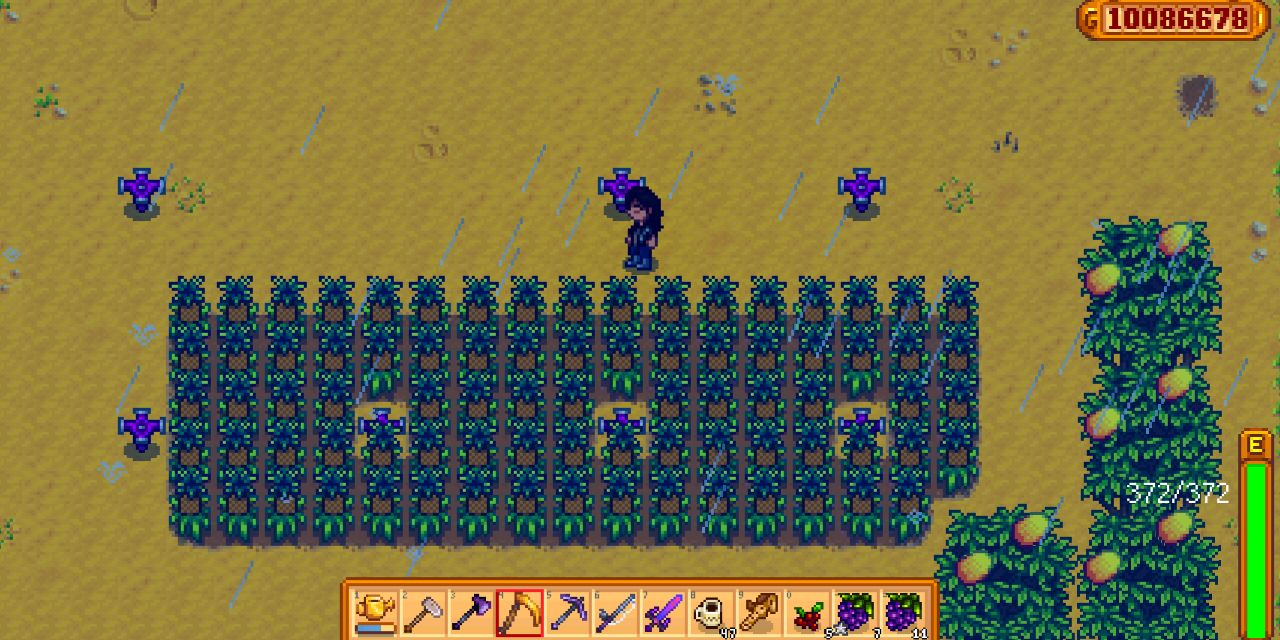
Since they take fourteen days to mature and 7 days to regrow, it's a waste to plant pineapples on the farm during the summer. These tropical fruits do grow year-round on Ginger Island, but for those who adopt to keep their farming in one identify, the greenhouse is a groovy option every bit well.
A regular pineapple harvest is vital for players trying to complete Caroline's "Island Ingredients" special social club from the community bulletin board. She requests 100 of these golden fruits, and then the greenhouse is a not bad infinite to apply.
Costs & Profits
Pineapple seeds are purchasable from the Island Trader for ane Magma Cap. Players may likewise detect them when slaying monsters in the Volcano Dungeon, or inside Golden Coconuts. They tin be sold as produce for the following prices:
| Quality | Without Tiller Profession | With Tiller Profession |
|---|---|---|
| Regular | 300g | 330g |
| Silverish | 375g | 412g |
| Golden | 450g | 495g |
| Iridium | 600g | 660g |
Players can also plough pineapples into Jam or Wine to increase profits:
| Item | Without Artisan Profession | With Artisan Profession |
|---|---|---|
| Jelly | 650g | 910g |
| Vino (regular) | 900g | 1260g |
| Vino (argent) | 1125g | 1575g |
| Wine (gold) | 1350g | 1890g |
| Wine (iridium) | 1800g | 2250g |
x Blueberries
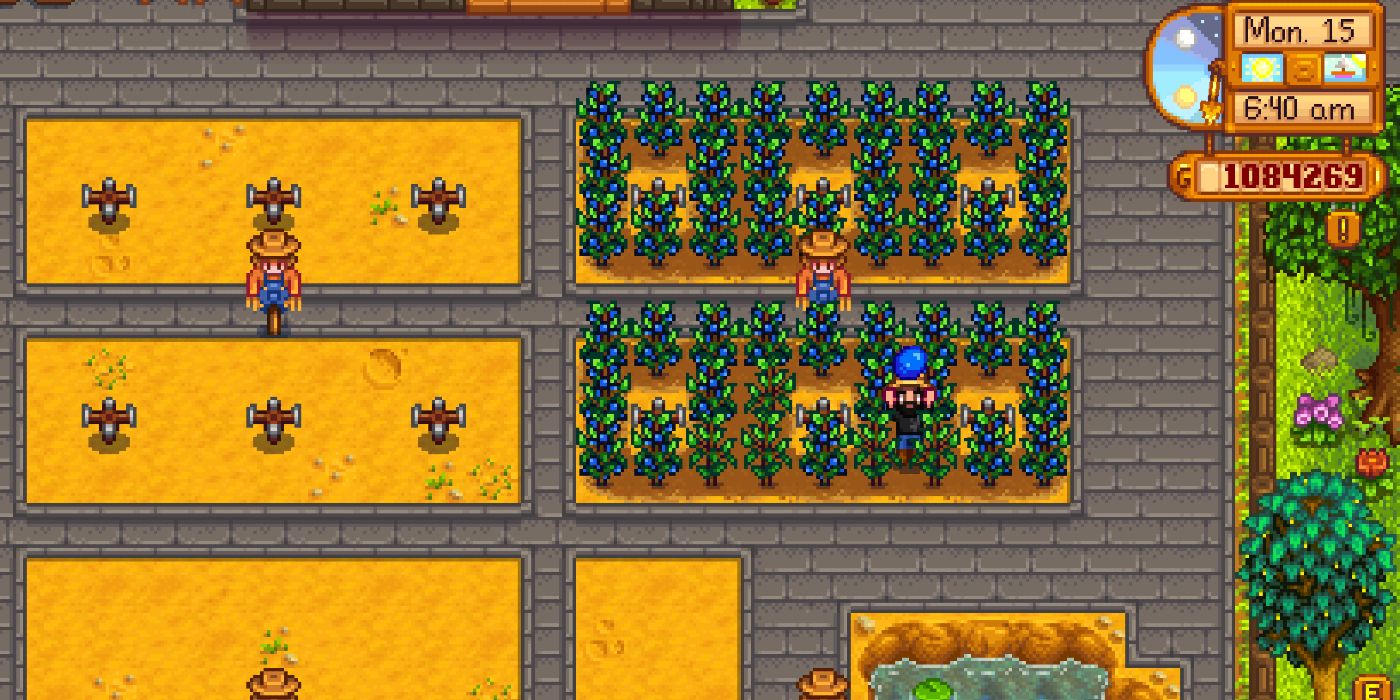
This summer crop takes a long time to accomplish its full potential, since information technology requires thirteen days to mature. Planting them indoors, however, allows the plant to remain standing and keep reproducing even after its usual season ends.
Since these plants produce multiple berries at each harvest, just a few bushes allow the histrion to collect hundreds of blueberries. Non only tin can the player turn these into assisting artisan goods, only they can likewise use them to brand Blueberry Tart, a great gift for many villagers.
Costs & Profits
Blueberry Seeds can be bought during the summer for 80g at Pierre's, and blueberries sell for:
| Quality | Without Tiller | With Tiller |
|---|---|---|
| Regular | 50g | 55g |
| Silver | 62g | 68g |
| Gold | 75g | 82g |
| Iridium | 100g | 110g |
When turned into Jam or Wine with the Preserves Jar or Keg, respectively, the farmer can earn:
| Item | Without Artisan | With Artisan |
|---|---|---|
| Jelly | 150g | 210g |
| Wine (regular) | 150g | 210g |
| Wine (silver) | 187g | 261g |
| Wine (gilt) | 225g | 315g |
| Wine (iridium) | 300g | 420g |
9 Cranberries

Like blueberries, these autumn crops each yield multiple units at harvest, and keep reproducing upon maturity. Nonetheless, they consummate their growth cycle in well-nigh half the fourth dimension that blueberries practice, making them an even improve selection for greenhouse growing.
Equally with other fruits, players can place their cranberries in preserves jars or kegs to make valuable artisan goods. They're as well a key ingredient in various recipes, such as Stuffing, Cranberry Sauce, and Super Meal, all of which provide excellent buffs. Alternatively, gift these abode-cooked dishes to neighbors to win them over!
Costs & Profits
Players have two options to buy Cranberry seeds in the fall: at Pierre's for 240g, or 300g at JojaMart. The berries themselves sell for:
| Quality | Without Tiller | With Tiller |
|---|---|---|
| Regular | 75g | 82g |
| Argent | 93g | 102g |
| Gold | 112g | 123g |
| Iridium | 150g | 165g |
Cranberry artisan goods, meanwhile, fetch the following prices:
| Particular | Without Artisan | With Artisan |
|---|---|---|
| Jelly | 200g | 280g |
| Wine (regular) | 225g | 315g |
| Wine (silverish) | 281g | 393g |
| Vino (gold) | 337g | 471g |
| Wine (iridium) | 450g | 630g |
8 Corn
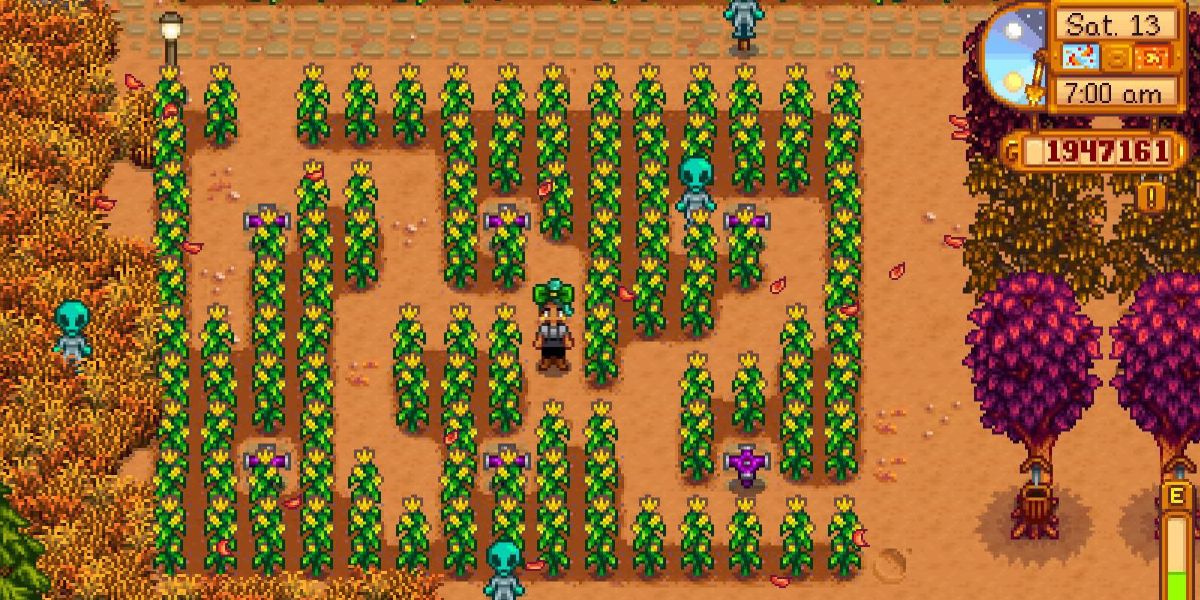
Just like in the real world, corn has a lot of versatile uses in Stardew Valley. It'southward used in several recipes, and tin be pressed into oil which is essential for cooking. Growing information technology outside, though, can get a little deadening since it takes so long to mature.
Even though it grows in both summer and fall exterior, greenhouse-grown corn lets the player reap greater rewards after that long wait. Using the final product in an oil maker allows the player to melt tons of helpful recipes.
Costs & Profits
Like about seeds, Corn Seeds are cheaper at Pierre'southward, costing 150g as opposed to 187g at JojaMart. The mature product sells for:
| Quality | Without Tiller | With Tiller |
|---|---|---|
| Regular | 50g | 55g |
| Silver | 62g | 68g |
| Aureate | 75g | 82g |
| Iridium | 100g | 110g |
Equally the first vegetable listed hither, the artisan products for Corn are a bit different. Instead of Jam and Wine, putting Corn in a Preserves Jar or Keg will upshot in Pickles or Juice, respectively. Different Vino, Juice cannot be aged in a Cask to increase quality. Players can also place Corn in an Oil Maker to brand Oil, a cardinal ingredient in several cooking recipes.
| Particular | Without Artisan | With Artisan |
|---|---|---|
| Pickles | 150g | 210g |
| Juice | 110g | 156g |
| Oil | 100g | 100g |
seven Giant Crops
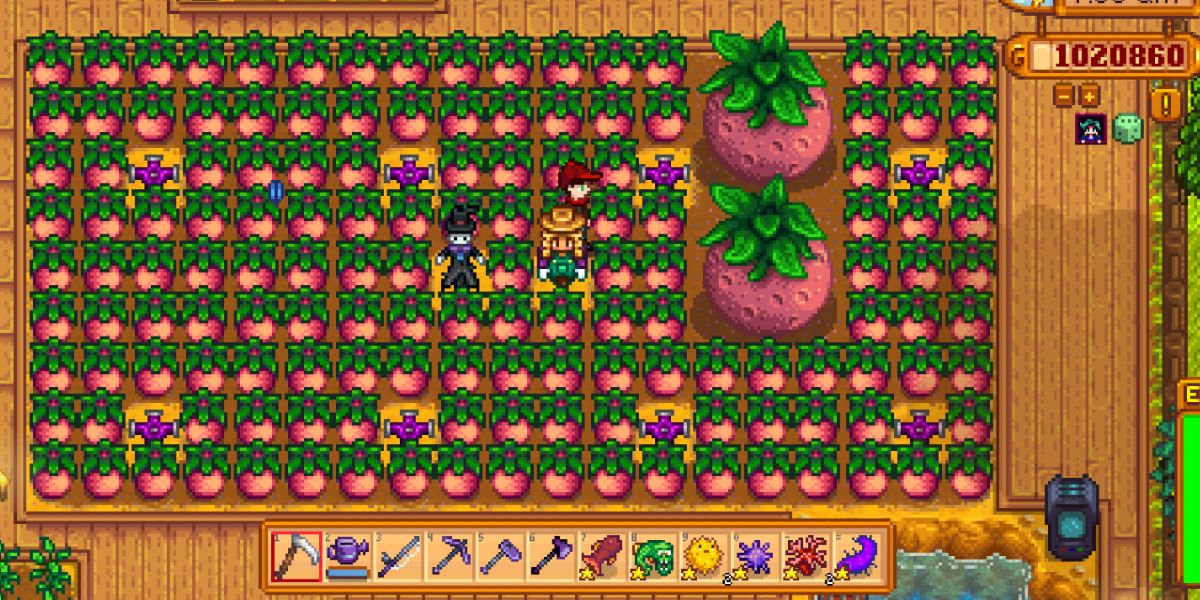
Cauliflower, melons, and pumpkins all accept the potential to form giant crops. Whatsoever 3x3 square of these crops may, on whatever day in one case fully grown, mutate into a giant form. This can exist cleaved apart with an axe to yield 15-21 items.
Players have to leave their plants lonely for awhile in order for this to happen. Notwithstanding, regular crops die at the cease of their season. Planting these items in the greenhouse allows the thespian to let them sit indefinitely, offering more chances at a giant ingather.
Costs & Profits
Cauliflower and Melon seeds both price 80g at Pierre'south and 100g at JojaMart. Pumpkin seeds are 100g and 125g, respectively. Players can purchase Cauliflower seeds in Spring, Melon in Summer, and Pumpkin in Fall. Each particular'south produce fetches a different toll:
| Item | Without Tiller | With Tiller |
|---|---|---|
| Cauliflower (regular) | 175g | 192g |
| Cauliflower (silver) | 218g | 239g |
| Cauliflower (gold) | 262g | 288g |
| Cauliflower (iridium) | 350g | 385g |
| Melon (regular) | 250g | 275g |
| Melon (silver) | 312g | 343g |
| Melon (gold) | 375g | 412g |
| Melon (iridium) | 500g | 550g |
| Pumpkin (regular) | 320g | 352g |
| Pumpkin (silver) | 400g | 440g |
| Pumpkin (gold) | 480g | 528g |
| Pumpkin (iridium) | 640g | 704g |
Vegetables Cauliflower and Pumpkin can be used to make Pickles or Juice, while Melon, as a fruit, tin make Jam or Wine.
| Item | Without Artisan | With Artisan |
|---|---|---|
| Pickled Cauliflower | 400g | 560g |
| Melon Jelly | 550g | 770g |
| Pickled Pumpkin | 690g | 966g |
| Cauliflower Juice | 393g | 550g |
| Melon Wine (regular) | 750g | 1050g |
| Melon Wine (silverish) | 937g | 1311g |
| Melon Vino (gold) | 1125g | 1575g |
| Melon Wine (iridium) | 1500g | 2100g |
| Pumpkin Juice | 720g | 1008g |
6 Cactus Fruit
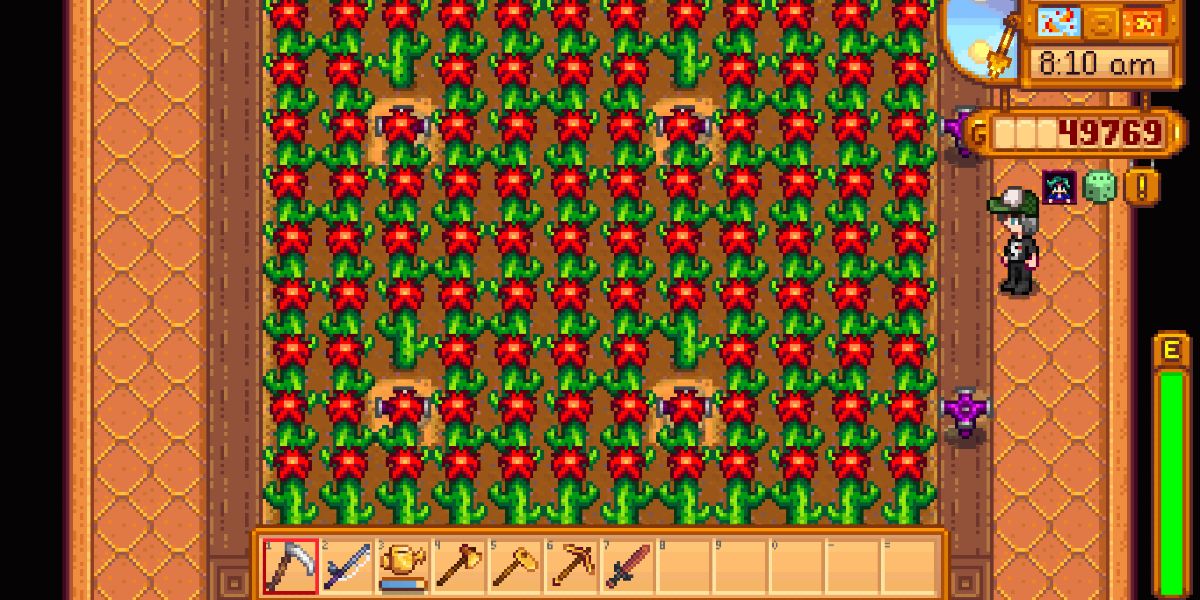
Since they've adapted to abound in the scorching air of Calico Desert, cactus fruits don't abound at all on the player'due south farm, even in summer. Withal, they flourish in the greenhouse, where they bear fruit every three days after maturing.
Though they're not massively valuable on their own, players can also turn their cactus fruit harvest into jelly with a preserves jar, or brew them into wine with a keg. Additionally, these desert delicacies make top-tier gifts for Pam, Linus and Sam.
Costs & Profits
Cactus Fruit seeds toll 150g at Sandy's store, the Oasis, in Calico Desert. Players can only purchase them after completing the Vault section of the Community Center/JojaMart, which will issue in the passenger vehicle being restored. The fruit itself sells for:
| Quality | Without Tiller | With Tiller |
|---|---|---|
| Regular | 75g | 82g |
| Silver | 93g | 102g |
| Gold | 112g | 123g |
| Iridium | 150g | 165g |
Cactus Fruit artisan goods, meanwhile, will sell for the following prices:
| Detail | Without Artisan | With Artisan |
|---|---|---|
| Jelly | 200g | 280g |
| Wine (regular) | 225g | 315g |
| Wine (silver) | 281g | 393g |
| Wine (gold) | 337g | 471g |
| Vino (iridium) | 450g | 630g |
five Starfruit
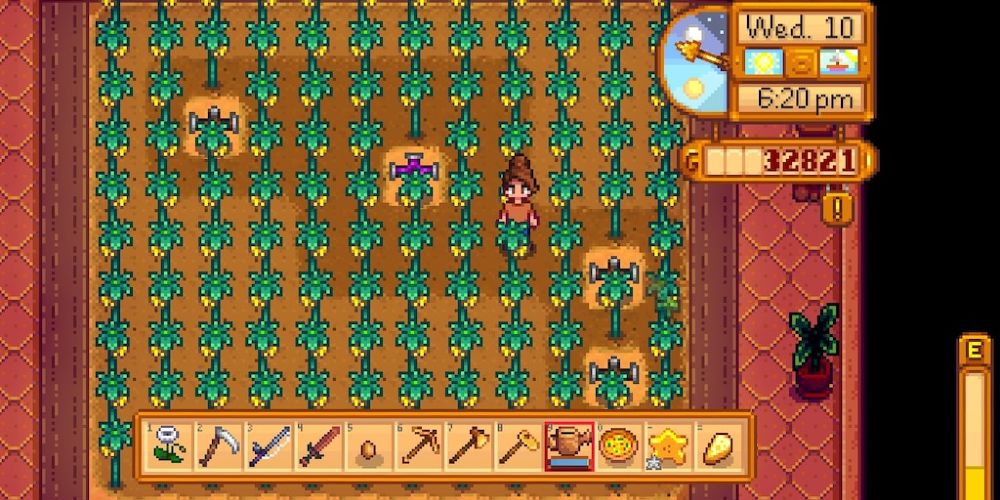
These summer seeds, as well purchased from Sandy, yield i of the game'southward most profitable crops. Even so, they take thirteen days to mature without the use of Speed-Gro. This makes them a great candidate for greenhouse farming, since the player is no longer express to the summer season.
Once the role player reaps the rewards of their harvest, they can sell their starfruit for high prices, or turn them into artisan goods as with cactus fruit. They tin can also use the Seed Maker to multiply the number of starfruit they grow.
Costs & Profits
Their 400g price tag may seem steep; all the same, Starfruit seeds are worth the cost, as players can see from the sell price tables below:
| Quality | Without Tiller | With Tiller |
|---|---|---|
| Regular | 750g | 825g |
| Silver | 937g | 1030g |
| Gold | 1125g | 1237g |
| Iridium | 1500g | 1650g |
When it comes to artisan goods, players tin make even grander amounts gold from their greenhouse Starfruit crop:
| Item | Without Artisan | With Artisan |
|---|---|---|
| Jelly | 1550g | 2170g |
| Wine (regular) | 2250g | 3150g |
| Wine (silverish) | 2812g | 3936g |
| Wine (gilded) | 3375g | 4725g |
| Wine (iridium) | 4500g | 6300g |
4 Coffee
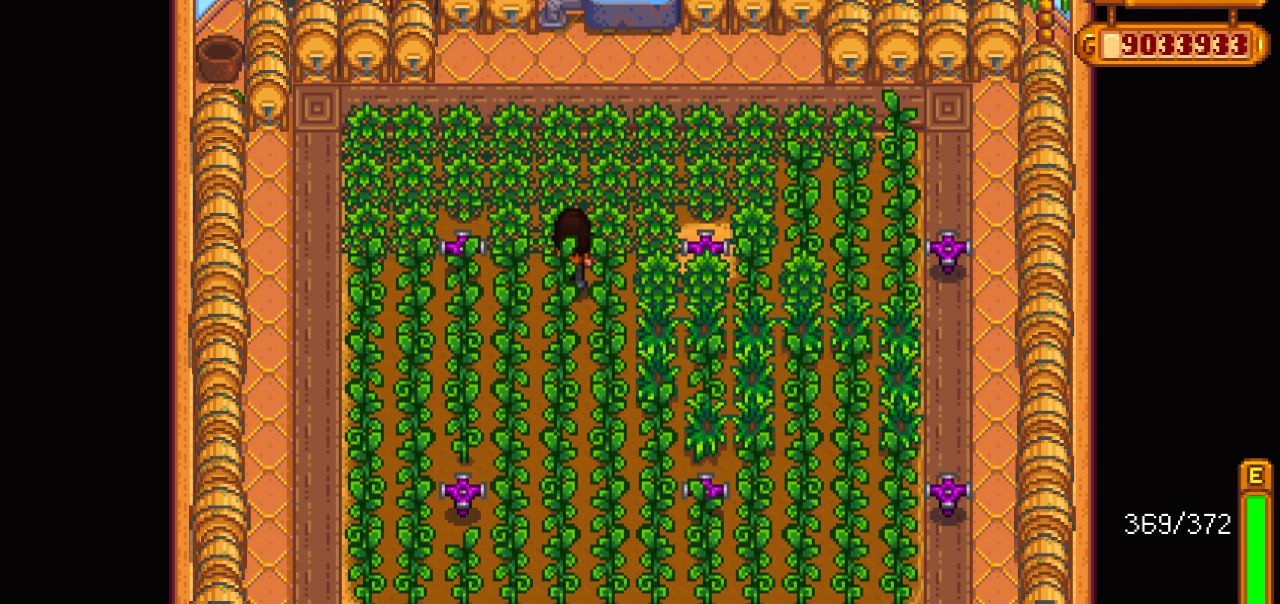
Speed boosts are invaluable in Stardew Valley, in every aspect of the game. If the player grows coffee in the greenhouse, they'll never have to move at normal speed once more.
Coffee produces continually once grown, dissimilar single-harvest crops like starfruit. This ways that in the greenhouse, they never die. But a few coffee plants can provide a huge surplus of the delicious drink, since they produce four beans every other day. Additionally, this can help players complete Qi'due south Culinary Challenge by giving them the ingredients for lots of triple espresso.
Costs & Profits
For reasons unclear, players may find them dropped by Dust Sprites, which roam levels 40-69 in the Mines. The Traveling Cart may likewise sell them for anywhere between 100g – 1000g. Nigh players volition likely notice themselves making coffee in kegs rather than selling the beans, but those strapped for cash can earn a few coins:
| Quality | Sell Cost |
|---|---|
| Regular | 15g |
| Argent | 18g |
| Golden | 22g |
| Iridium | 30g |
Since coffee products are classed as cooked food rather than artisan goods, they practice non benefit from the Artisan profession. However, they are worth including here as Triple Espresso is amongst the most valuable cooked dishes.
| Detail | Sell Price |
|---|---|
| Coffee | 150g |
| Triple Espresso | 450g |
3 Ancient Fruit
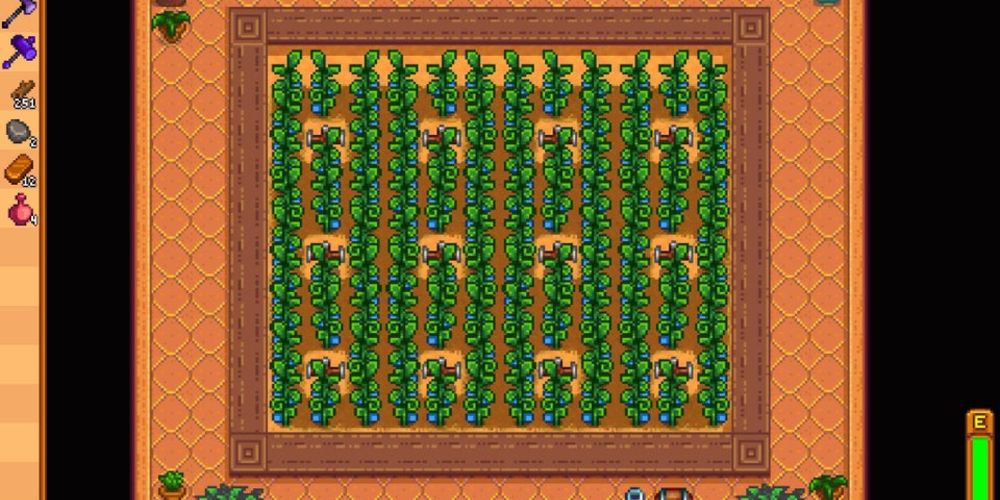
The player outset acquires Ancient Seeds from Gunther, after donating the artifact of the same name. Though they tin be planted in any season except winter, they have 28 days to grow. Like coffee, however, aboriginal fruit becomes immortal in the greenhouse since it'due south a reproducing ingather.
This crop is surpassed in value simply by starfruit and sweet gem berries. Greenhouse-grown ancient fruit provides the player with an infinite source of income, making them one of the best options for this section of the farm.
Costs & Profits
Artisan seeds cannot be purchased; players must either receive them equally a reward from Gunther or
| Quality | Without Tiller | With Tiller |
|---|---|---|
| Regular | 550g | 605g |
| Silver | 667g | 755g |
| Gold | 825g | 907g |
| Iridium | 1100g | 1210g |
| Particular | Without Artisan | With Artisan |
|---|---|---|
| Jelly | 1150g | 1610g |
| Wine (regular) | 1650g | 2310g |
| Vino (silver) | 2062g | 2886g |
| Wine (gold) | 2475 | 3465g |
| Wine (iridium) | 3300g | 4620g |
2 Fruit Trees
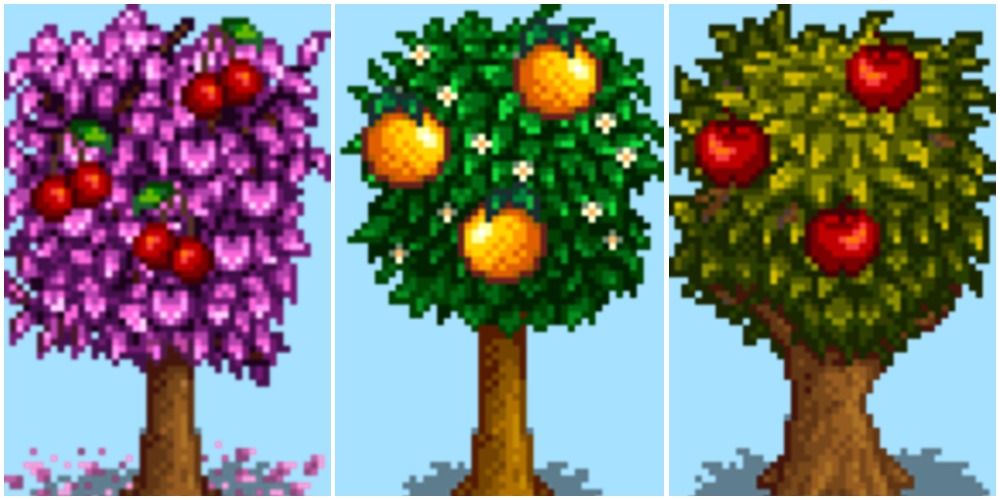
Fruit copse typically have a single flavour in which they produce fruit. Inside the greenhouse, though, they bear fruit twelvemonth-round. This massively increases their profit margin, since it means they produce 4 times as much fruit equally they would exterior.
Any of the fruit trees are essential for a thespian to accept on their farm (except for Bananas and Mangoes, which are all-time planted on Ginger Island). Equally with all other fruits, turning them into wine or jelly increases turn a profit even farther, especially with the Artisan profession. Orchard fruits are also high on every villager'southward gift list.
xCosts & Profits
All fruit tree saplings are available to purchase at Pierre's, and their prices vary as follows:
- Apricot: 2000g
- Cherry: 3400g
- Peach: 6000g
- Orange: 4000g
- Apple tree: 4000g
- Pomegranate: 6000g
| Item | Without Tiller | With Tiller |
|---|---|---|
| Regular |
|
|
| Silver |
|
|
| Gold |
|
|
| Iridium |
|
|
| Item | Without Artisan | With Artisan |
|---|---|---|
| Jelly |
|
|
| Wine (regular) |
|
|
| Wine (silverish) |
|
|
| Wine (gilded) |
|
|
| Wine (iridium) |
|
|
1 Sweet Gem Berries
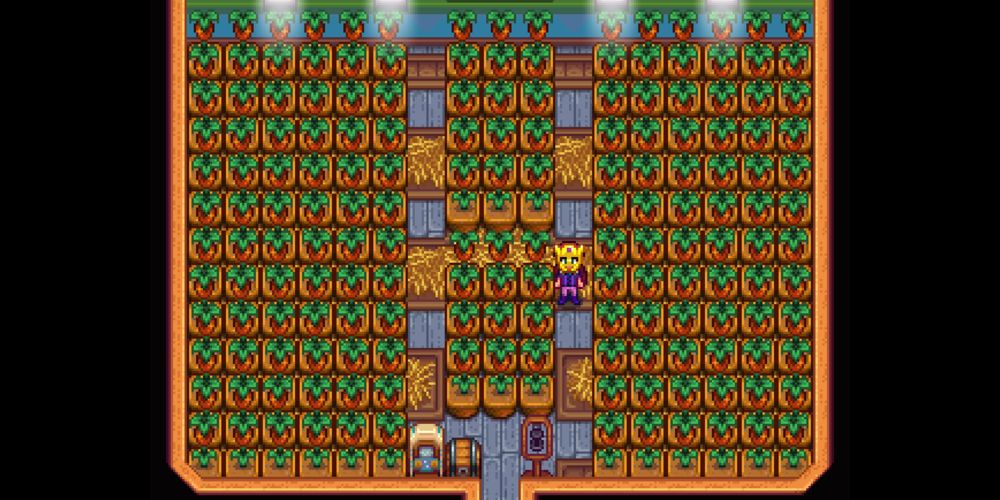
This ingather grows agonizingly slowly. If the player doesn't plant the Rare Seed on the first day of Fall, there'south no hope of harvesting it, since it takes a total 28 days to mature. Planting information technology in the greenhouse, nonetheless, removes this pressure.
The role player can give one Sweet Gem Berry to Old Principal Cannoli'southward statue, assuasive them to access a Stardrop. All the same, these berries are also very profitable if the player replicates them with the Seed Maker. Since they sell for iii,000g at their lowest quality, they're a corking way to use the greenhouse.
Costs & Profits
Rare Seeds have but one source, and they're quite expensive: players can buy them for 1000g from the Traveling Cart. One time one or two seeds has been grown to maturity, it is recommended that players utilise the Seed Maker to obtain more, in gild to save a few gold. The fruits, however, are quite valuable, even though they cannot be made into artisan goods.
| Quality | Sell Cost |
|---|---|
| Regular | 3000g |
| Argent | 3750g |
| Aureate | 4500g |
| Iridium | 6000g |
About The Author
Source: https://gamerant.com/stardew-valley-best-greenhouse-crops/

0 Response to "Stardew Valley What to Grow in the Greenhouse"
Post a Comment